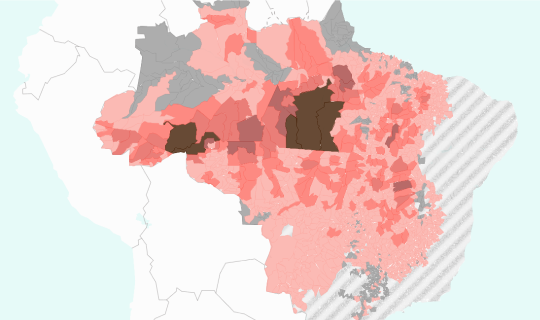The EU and China are top importing markets for forest-risk commodities and, as a consequence, the markets most exposed to deforestation. Together, they were exposed to approximately 40% of all deforestation embodied in the direct trade of agricultural commodities in the period 2020–2022. They therefore play a pivotal role in shaping the future sustainability of these commodity supply chains.
Last year the EU introduced a new regulation that requires importing and exporting companies to ensure supply chains are free of deforestation. Yet, several concerns have been identified regarding the effectiveness and equity of the EU Deforestation Regulation (EUDR), including the lack of participation by producer countries in its design and the risk of excluding smallholders ill-equipped to comply with its requirements.
One of the biggest challenges concerns the risk of ‘leakage’ and market bifurcation. That is, rather than reducing deforestation, producers and traders supply European markets with commodities free of recent deforestation and redirect commodities produced on deforested lands to other major importing markets such as China, potentially negating the benefit of the regulation.
The risk of leakage has sparked debate around the potential for alignment between EU and Chinese strategies to address imported deforestation. Drawing on interviews with experts in China and Europe, new research led by Trase sheds light on the main factors influencing the prospects of China adopting measures to address imported deforestation in the context of potential policy convergence between the two major importing markets.
Encouraging signs
There has been growing support for legislation in industrialised economies against imported deforestation. Aside from the EUDR, which will start being implemented from January 2025, other importing markets including the UK and US are developing policies against deforestation associated with commodity trade.
Early signals are also coming from China. The Asian country has markedly increased its ambitions to be viewed as a leader in tackling climate change and has indicated willingness to address imported deforestation. These include signing the Glasgow Forest Declaration and the release of a number of joint statements with trading partners including the EU (2021), US (2021) and Brazil (2023) which recognise the need to address global deforestation.
Despite these hopeful signs from high-level Chinese leadership, there are potential obstacles in the way of China enacting robust measures on imported deforestation.
Concerns primarily relate to the risks of increased commodity prices if additional barriers to trade were to be imposed, potentially having an adverse effect on China’s food security. Hard lessons from past food shortages coupled with rapid urbanisation and increasing demand for meat by a wealthier population have made food security a top national priority for China.
Conversely, food security concerns may motivate action to tackle deforestation if climate impacts threaten China’s food supply or destabilise prices. A number of recent studies have shown that deforestation and climate change lead to negative impacts in agricultural productivity in countries such as Brazil and China.
Another critical barrier relates to China’s longstanding foreign policy principle of non-interference. Introducing measures that impose extraterritorial control, such as a requirement for deforestation-free supply chains, could be perceived by Chinese policy makers as undue interference in the sovereignty of other countries. In addition, the lack of evidence on the effectiveness of consumer-led measures is also seen as a factor that hinders political support.
Paving the way?
Nevertheless, the research suggests that the EUDR could create conditions that might pave the way for China to adopt green supply chain policies.
Two mechanisms in the regulation have the potential to incentivise cooperation and policy alignment between the EU and other importing markets. First, by requiring companies to implement full traceability for exports to the EU, the new regulation will make it technically easier for China to follow suit and require its companies to demand the same level of information from their suppliers. This may be reinforced by the fact that the main companies trading the three main forest-risk commodities – soy, beef and palm oil – are the same for both the EU and China. Traceability provides importing countries with critical information to identify and manage supply chain risks including food safety and supply disruptions. These advantages resonate deeply with China's food security concerns.
Second, the knowledge and lessons generated by the EUDR’s implementation, including regarding the technical design, enforcement of traceability and impact assessment, can inform both Chinese domestic policy and the development of future bilateral mechanisms on environmental issues on which China recognises the EU as a leading partner.
The prospects of convergence
It remains to be seen whether these enabling conditions will outweigh the perceived obstacles for China to adopt measures to address deforestation linked to its commodity imports. Ultimately the Chinese government may be more inclined to introduce voluntary guidelines and be more supportive of implementing regulations focused on illegal deforestation in line with their trading partner’s own land-use laws. Such a legality-based approach to regulating trade is what other importing countries such as the UK and the US already favour.
The combination of the EUDR and the adoption of legality-based measures targeted at illegal deforestation by China could push trading companies to adopt a uniform standard across their global operations instead of tailoring their operations to comply with different regulatory standards for different markets. The lack of information on deforestation licences and data inconsistencies across countries means that verifying and monitoring illegal deforestation embodied in trade products involves more complex and costlier mechanisms than checking compliance with deforestation-free requirements. For some places, identifying and filtering out only illegal deforestation may be unfeasible. These challenges may generate the economic and technical incentives for trading companies to expand compliance with zero-deforestation standards to other markets such as China, rather than developing more complex and costly solutions to deal only with illegal deforestation.
While the prospects of full policy convergence between the EU and China in the short to medium term seem unlikely, the effective implementation of the EUDR, combined with voluntary commitments by companies to scale up more rigorous traceability and transparency systems, open the door for meaningful longer term alignment of demand-side regulations aimed at tackling deforestation linked to commodity trade.
The research paper is available at: André A. Vasconcelos, Mairon G. Bastos Lima, Toby A. Gardner, Constance L. McDermott, Prospects and challenges for policy convergence between the EU and China to address imported deforestation, Forest Policy and Economics, Volume 162, 2024, 103183, ISSN 1389-9341, https://doi.org/10.1016/j.forpol.2024.103183
Was this article useful?





